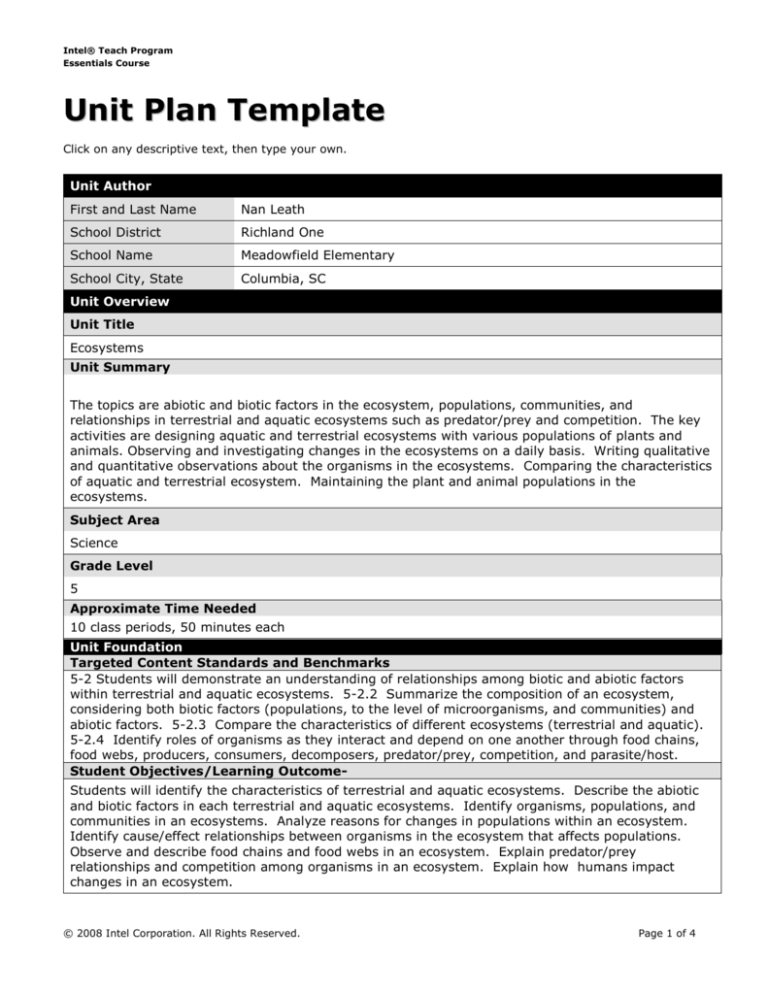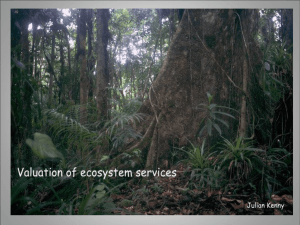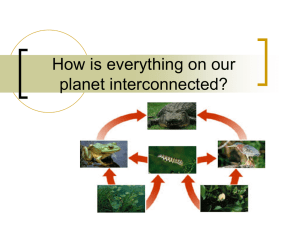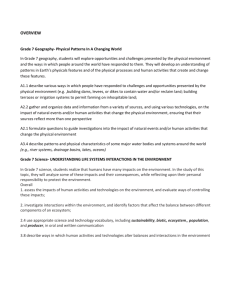
Intel® Teach Program
Essentials Course
Unit Plan Template
Click on any descriptive text, then type your own.
Unit Author
First and Last Name
Nan Leath
School District
Richland One
School Name
Meadowfield Elementary
School City, State
Columbia, SC
Unit Overview
Unit Title
Ecosystems
Unit Summary
The topics are abiotic and biotic factors in the ecosystem, populations, communities, and
relationships in terrestrial and aquatic ecosystems such as predator/prey and competition. The key
activities are designing aquatic and terrestrial ecosystems with various populations of plants and
animals. Observing and investigating changes in the ecosystems on a daily basis. Writing qualitative
and quantitative observations about the organisms in the ecosystems. Comparing the characteristics
of aquatic and terrestrial ecosystem. Maintaining the plant and animal populations in the
ecosystems.
Subject Area
Science
Grade Level
5
Approximate Time Needed
10 class periods, 50 minutes each
Unit Foundation
Targeted Content Standards and Benchmarks
5-2 Students will demonstrate an understanding of relationships among biotic and abiotic factors
within terrestrial and aquatic ecosystems. 5-2.2 Summarize the composition of an ecosystem,
considering both biotic factors (populations, to the level of microorganisms, and communities) and
abiotic factors. 5-2.3 Compare the characteristics of different ecosystems (terrestrial and aquatic).
5-2.4 Identify roles of organisms as they interact and depend on one another through food chains,
food webs, producers, consumers, decomposers, predator/prey, competition, and parasite/host.
Student Objectives/Learning OutcomeStudents will identify the characteristics of terrestrial and aquatic ecosystems. Describe the abiotic
and biotic factors in each terrestrial and aquatic ecosystems. Identify organisms, populations, and
communities in an ecosystems. Analyze reasons for changes in populations within an ecosystem.
Identify cause/effect relationships between organisms in the ecosystem that affects populations.
Observe and describe food chains and food webs in an ecosystem. Explain predator/prey
relationships and competition among organisms in an ecosystem. Explain how humans impact
changes in an ecosystem.
© 2008 Intel Corporation. All Rights Reserved.
Page 1 of 4
Intel® Teach Program
Essentials Course
Curriculum-Framing Questions
Essential
Why is the ecosystem important?
Question
Unit
Questions
What are types of terrestrial and aquatic ecosystems? How do plants and
animals depend on abiotic factors in the ecosystem? What are some of the
relationships between plants and animals in the ecosystems? Why are these
relationships important?
Content
Questions
What are biotic factors? What are abiotic factors? What is the difference
between organism, population, and community? What is an example of a food
chain and food web in each type of ecosystem? What effect does
predator/prey have on the populations in an ecosystem? How do human
activities affect ecosystems? What can you do to protect the ecosystem?
Assessment Plan
Assessment Timeline
Before project work begins
Lab Safety in
terms of
handling live
animals in the
classroom.
Draw lab
safety posters
and write the
rule that is
illustrated
KWL
Students work on projects
and complete tasks
FOSS
What do you
know about
ecosystems?
Environments
Investigation
Questions and
Lab Sheets
Lab Reports
and
Powerpoint
presentations
After project work is
completed
FOSS Home
School
Connection
Sheets
FOSS Post-
Assessment
Test
Graphic organizer
on terrestrial and
aquatic
ecosystems
Lab Safety quiz
Assessment Summary
Assessment for the Environments unit primarily comes from the FOSS Investigation sheets. Begin
the unit by discussing the safe handling and care for animals in the classroom. Students make
posters of the lab rules and include the rule with an illustration. Follow up with a lab
safety/procedures quiz. Use KWL and graphic organizers to assess previously taught objectives in life
science and to help students organize information. Each FOSS investigation includes the lab sheets
that coordinate with the experiments. The investigation sheets are inquiry-based that include all
aspects of scientific and experimental procedures. The teacher will assess process skills as well
content by utilizing the FOSS investigation sheets. Students also receive Home School Connection
activity sheets that reinforce the concepts taught in class. Finally, the post-assessment is a FOSS
cumulative assessment that allows the teacher to evaluate the students’ mastery of the inquiry
process skills as well as content knowledge of the unit.
© 2008 Intel Corporation. All Rights Reserved.
Page 2 of 4
Intel® Teach Program
Essentials Course
Unit Details
Prerequisite Skills
Students must have lab safety and procedures instruction before beginning the environment unit.
Students must be able to identify the abiotic and biotic factors in an ecosystem. They must have
background knowledge of the relationships in an ecosystem. Students must have previous
experience writing quantitative and qualitative observations. Students should have previous
knowledge of science process skills such as scientific method, observation, inference, drawing
conclusions, and analyzing results.
Instructional Procedures
Each lesson begins with a simple investigation or demonstration that leads into the experimental
process. Students follow specific scientific procedures to make a terrestrial and aquatic ecosystem.
Students develop a plan to maintain a balance in the ecosystem tanks so they can monitor and
observe changes in populations, water quality, food supply, etc. Students will write daily qualitative
and quantitative observations about each type of ecosystem. They must keep track of the population
count of each species of animal and plant in the tanks. Students must write about any relationships
they observe such as predator/prey, competition for food during feeding time, and competition for
shelter. Over the period of time for this unit, the students will maintain their ecosystem log and
follow the FOSS investigations in the kit.
Accommodations for Differentiated Instruction
Special Needs
Students
Students work in cooperative groups. Students with disabilities are
guided through the lesson by having the questions read to them if
necessary.
Nonnative
Speakers
FOSS kits come with Spanish investigation sheets and assessments.
Gifted/Talented
Students
FOSS kits come equipped with module booklets that contain enrichment articles
and related minilabs that can be done independently. Also, there are
extracurricular activities that correlate the science concepts with math and
language arts.
Materials and Resources Required For Unit
Technology – Hardware (Click boxes of all equipment needed)
Camera
Laser Disk
VCR
Computer(s)
Printer
Video Camera
Digital Camera
Projection System
Video Conferencing Equip.
DVD Player
Scanner
Other Smart Board
Internet Connection
Television
Technology – Software (Click boxes of all software needed.)
Database/Spreadsheet
Image Processing
Web Page Development
Desktop Publishing
Internet Web Browser
Word Processing
E-mail Software
Multimedia
Other Powerpoint
Encyclopedia on CD-ROM
Printed Materials
FOSS Investigation notebook, FOSS Environments booklets, student
notebooks with accompanying lab sheets
© 2008 Intel Corporation. All Rights Reserved.
Page 3 of 4
Intel® Teach Program
Essentials Course
Supplies
Internet Resources
Other Resources
Plastic aquarium tanks with lids, soil, moss, elodea, treated water for
aquatic animals, millipedes, mosquito fish, African dwarf frogs, brine
shrimp, sea salt, ghost shrimp, crayfish, earthworms, Bess beetles,
food supply for animals
www.fossweb.com
Career Day Biologist from DNR guest speaker, field trip to SC estuary
Copyright © 2008 Intel Corporation. All rights reserved. Intel, the Intel logo, Intel Education Initiative, and Intel Teach Program are trademarks
of Intel Corporation in the U.S. and other countries. *Other names and brands may be claimed as the property of others.
© 2000-2007 Intel Corporation. All Rights Reserved.
Page 4 of 4









